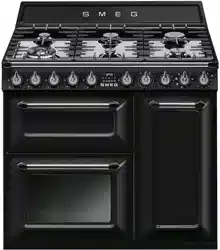Documents: Go to download!
User Manual
- User Manual - (English)
- Specifications Sheet - (English)
- Description
- Use
- Cleaning and maintenance
Table of contents
Owner Manual Ovens
Description
General Description

- Backguard
- Cooking hob
- Control panel
- Oven light
- Seal
- Door
- Fan
1, 2, 3... Rack/tray support frame shelf
Cooking hob

AUX = Auxiliary
SR = Semi-rapid
R = Rapid
UR = Ultra rapid
Control panel

Hob burner knobs (1)
Useful for lighting and adjusting the hob burners.
Press and turn the knobs anti-clockwise to the value  to light the relative burners. Turn the knobs to the zone between the maximum
to light the relative burners. Turn the knobs to the zone between the maximum  and minimum
and minimum  setting to adjust the flame.
setting to adjust the flame.
Return the knobs to the  position to turn off the burners.
position to turn off the burners.
Programmer clock (2)
Useful for displaying the current time, setting programmed cooking operations and programming the minute minder timer.
Auxiliary oven variable grill knob (3)
It turns on the light inside the oven or starts the grill heating element to a temperature ranging from a minimum of 50°C to a maximum of 245°C.
Auxiliary oven variable grill indicator light (4)
The indicator light comes on to indicate that the auxiliary oven is heating up. It turns off as soon as it reaches the set temperature. It flashes regularly to indicate that the temperature set inside the oven is kept constant.
Lower multifunction oven temperature knob (5)
This knob allows you to select the cooking temperature and the Vapor Clean temperature.
Turn the knob clockwise to the required value, between the minimum and maximum setting.
Lower multifunction oven indicator light (6)
The indicator light comes on to indicate that the oven is heating up. It turns off as soon as it reaches the set temperature. It flashes regularly to indicate that the temperature set inside the oven is kept constant.
Lower multifunction oven function knob (7)
The oven's various functions are suitable for different cooking modes. After selecting the required function, set the cooking temperature using the temperature knob.
Side oven indicator light (8)
The indicator light comes on to indicate that the oven is heating up. It turns off as soon as it reaches the set temperature. It flashes regularly to indicate that the temperature set inside the oven is kept constant.
Side oven function knob (9)
It turns on the light inside the oven or starts the circulaire heating element to a temperature ranging from a minimum of 50°C to a maximum of 245°C.
Other parts
Shelves
The appliance features shelves for positioning trays and racks at different heights. The insertion heights are indicated from the bottom upwards (see 2.1 General Description).
Cooling fan
The fan cools the ovens and comes into operation during cooking.
The fan causes a steady outflow of air that exits from the rear of the appliance and which may continue for a brief period of time even after the appliance has been turned off.

Interior lighting
The internal light of the ovens comes on when any function is selected.
Available accessories
Important: Some models are not provided with all accessories.
Rack

Useful for supporting containers with food during cooking.
Tray rack

To be placed over the top of the oven tray; for cooking foods which may drip.
Oven tray

Useful for collecting fat from foods placed on the rack above.
Deep tray

Useful for collecting fat from foods placed on the rack above and for cooking pies, pizzas and baked desserts.
Plate rack

To be used for warming plates.
Reduction pan stand

Useful when using small cookware.
WOK reduction pan stand

Useful when using a wok.
Use
Instructions
WARNING - High temperature inside the oven during use
Danger of burns
- Keep the oven door closed during cooking.
- Protect your hands wearing heat resistant gloves when moving food inside the oven.
- Do not touch the heating elements inside the oven.
- Do not pour water directly onto very hot trays.
- Do not allow children younger than 8 years old to come near the appliance when in operation.
- If you need to move food or at the end of cooking, open the door 5 cm for a few seconds, let the steam come out, then open it fully.
WARNING - High temperature inside the storage compartment
Danger of burns
- Do not open the storage compartment when the oven is on and still hot.
- The items inside the storage compartment could be very hot after using the oven.
WARNING - Improper use
Danger of burns
- Make sure that the flame-spreader crowns are correctly positioned in their housings with their respective burner caps.
- Oils and fat could catch fire if overheated. Be very careful.
WARNING - High temperature inside the oven during use
Danger of fire or explosion
- Do not spray any spray products near the oven.
- Do not use or leave flammable materials near the oven or the storage compartment.
- Do not use plastic kitchenware or containers when cooking food.
- Do not put sealed tins or containers in the oven.
- Do not leave the oven unattended during cooking operations where fats or oils could be released.
- Remove all trays and racks which are not required during cooking.
WARNING - Improper use
Risk of damage to surfaces
- Do not cover the bottom of the oven cavity with aluminium or tin foil sheets.
- If you wish to use greaseproof paper, place it so that it will not interfere with the hot air circulation inside the oven.
- Do not place pans or trays directly on the bottom of the oven cavity.
- Do not use the open door to rest pans or trays on the internal glass pane.
- Do not pour water directly onto very hot trays.
- Make sure that the flame-spreader crowns are correctly positioned in their housings with their respective burner caps.
- The cooking vessels or griddle plates should be placed inside the perimeter of the hob.
- All pans must have smooth, flat bottoms.
- If any liquid does boil over or spill, remove the excess from the hob.
First use
- Remove any protective film from the outside or inside of the appliance, including accessories.
- Remove any labels (apart from the technical data plate) from the accessories and from the cooking compartments.
- Remove all the accessories from the appliance and clean them (see 4 Cleaning and maintenance). Heat the empty ovens at the maximum temperature to burn off any residues left by the manufacturing process.
Using the accessories
Racks and trays
Racks and trays have to be inserted into the side guides until they come to a complete stop.
The mechanical safety locks that prevent the rack from being taken out accidentally have to face downwards and towards the oven back.
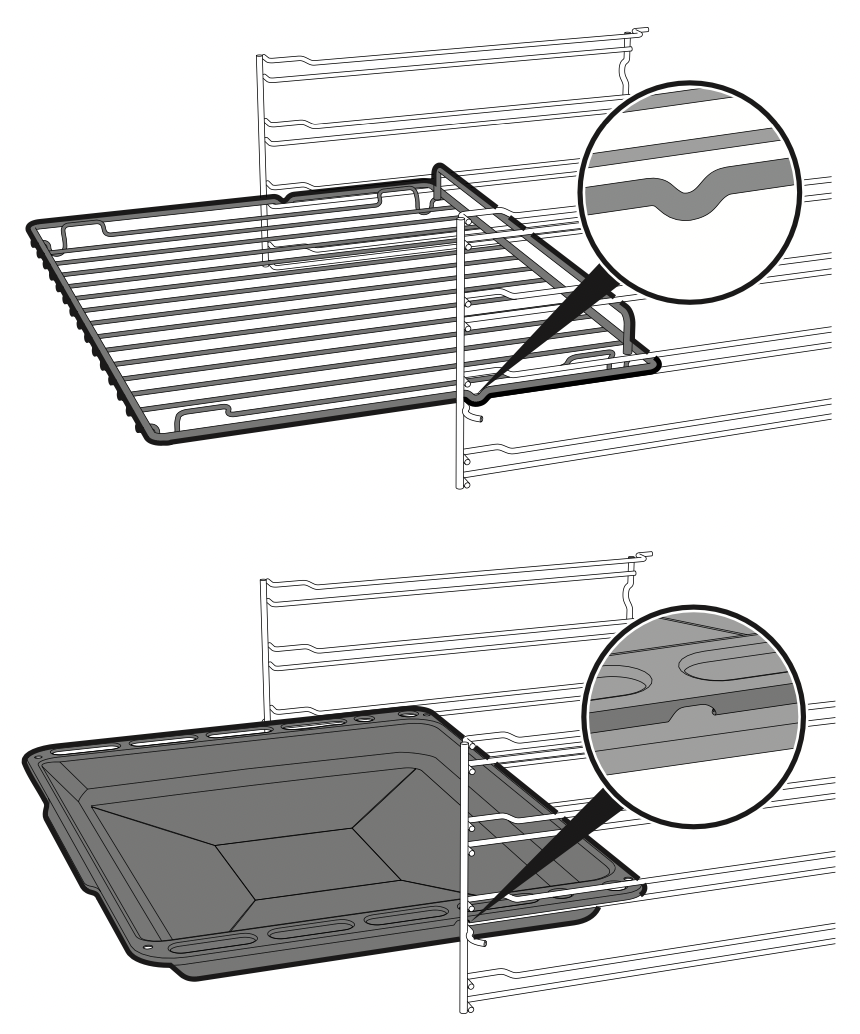
NOTE: Gently insert racks and trays into the oven until they come to a stop.
NOTE: Clean the trays before using them for the first time to remove any residues left by the manufacturing process.
Tray rack
The tray rack has to be inserted into the tray. In this way fat can be collected separately from the food which is being cooked.

Reduction pan stands
The reduction pan stands have to be placed on the hob grids. Make sure they are properly placed.

Plate rack
- Insert the plate rack without plates in the first shelf of the side oven.
- Position the plates as shown in the figure.
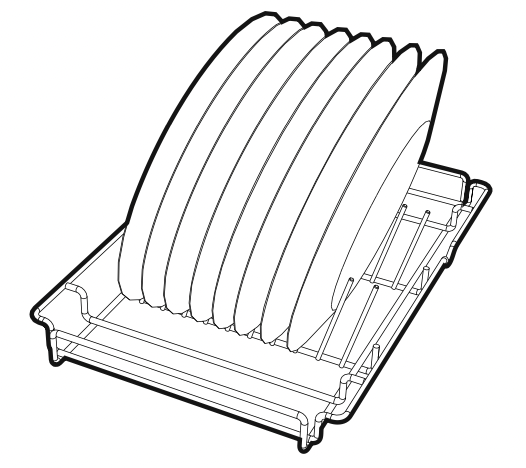
- Heat the oven to a temperature no greater than 50°C for no more than 15 minutes.
- After heating, extract the support slightly, leaving it on the rails.
- Ensure that the support is stable and balanced, then remove the plates.
NOTE: Use oven gloves when handling hot plates.
Using the hob
All the appliance's control and monitoring devices are located together on the front panel. The burner controlled by each knob is shown next to the knob. The appliance is equipped with an electronic ignition device. Simply press the knob and turn it anticlockwise to the maximum flame symbol, until the burner lights. If the burner does not light in the first 15 seconds, turn the knob to  and wait 60 seconds before trying again. After lighting, keep the knob pressed in for a few seconds to allow the thermocouple to heat up. The burner may go out when the knob is released: in this case, the thermocouple has not heated up sufficiently. Wait a few moments and repeat the operation. Keep the knob pressed in longer.
and wait 60 seconds before trying again. After lighting, keep the knob pressed in for a few seconds to allow the thermocouple to heat up. The burner may go out when the knob is released: in this case, the thermocouple has not heated up sufficiently. Wait a few moments and repeat the operation. Keep the knob pressed in longer.
NOTE: In case of an accidental switching off, a safety device will be tripped, cutting off the gas supply, even if the gas tap is open. Return the knob to  and wait at least 60 seconds before lighting it again.
and wait at least 60 seconds before lighting it again.
Correct positioning of the flamespreader crowns and burner caps
Before lighting the hob burners, make sure that the flame-spreader crowns are correctly positioned in their housings with their respective burner caps. Make sure that the holes in the flame-spreader crowns are aligned with the igniters and thermocouples (A).

Practical tips for using the hob
For better burner efficiency and to minimise gas consumption, use pans with lids and of suitable size for the burner, so that flames do not reach up the sides of the pan. Once the contents come to the boil, turn down the flame far enough to ensure that the liquid does not boil over.
Cookware diameters:
- Auxiliary: 12 - 14 cm.
- Semi-rapid: 16 - 24 cm.
- Rapid: 18 - 26 cm.
- Ultra-rapid: 18 - 28 cm.
Using the ovens
Switching on the multifunction oven

To switch on the multifunction oven:
- Select the cooking function using the function knob.
- Select the temperature using the temperature knob.
Opening and closing the doors of the multifunction/side ovens
The multifunction and side ovens are equipped with a swing door. To open, pull the door handle towards you. To close, push the doors until you hear a mechanical “click”.
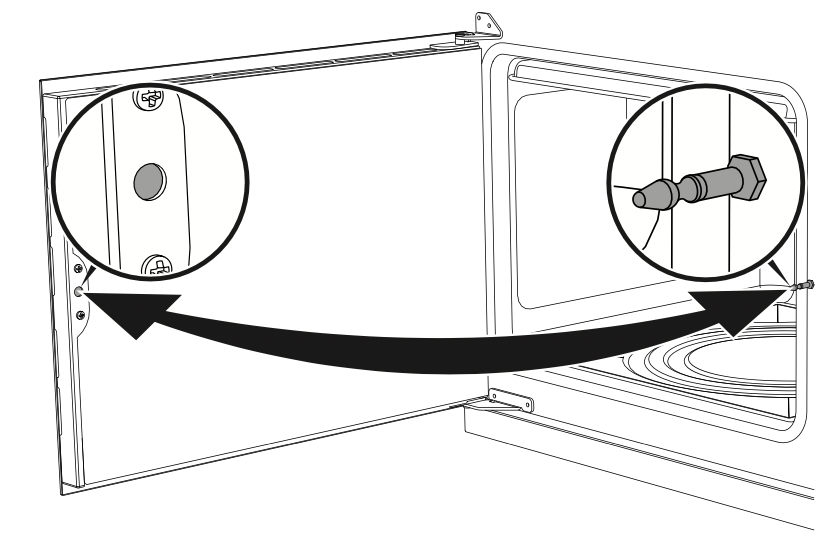
NOTE: The doors are not held in place when open and may tend to reclose. During use, pay attention not to come into contact with the internal glass pane to prevent burns.
NOTE: Over time the swing doors might get difficult to open and close. Grease the hinges.
Switching on the auxiliary oven

To switch on the auxiliary oven:
- Select the temperature using the variable grill knob. The temperature ranges indicatively from a minimum of 50°C and a maximum of 300°C.

Functions list
ECO
Depending on the function it is combined with, this ensures the greatest possible energy savings during cooking.
 Static
Static
As the heat comes from above and below at the same time, this system is particularly suitable for certain types of food. Traditional cooking, also known as static cooking, is suitable for cooking just one dish at a time. Perfect for all types of roasts, bread and cakes and in any case particularly suitable for fatty meats such as goose and duck.
 Lower element
Lower element
The heat coming just from the bottom allows you to complete the cooking of foods that require a higher bottom temperature, without affecting their browning. Perfect for cakes, pies, tarts and pizzas.
 Small grill
Small grill
Using only the heat released from the central element, this function allows you to grill small portions of meat and fish for making kebabs, toasted sandwiches and any types of grilled vegetable side dishes.
 Grill
Grill
The heat coming from the grill element gives perfect grilling results above all for thin and medium thickness meat and in combination with the rotisserie (where fitted) gives the food an even browning at the end of cooking. Perfect for sausages, spare ribs and bacon. This function enables large quantities of food, particularly meat, to be grilled evenly.
 Fan with grill
Fan with grill
The air produced by the fan softens the strong heatwave generated by the grill, grilling perfectly even very thick foods. Perfect for large cuts of meat (e.g. shin of pork).
 Fan assisted
Fan assisted
The operation of the fan, combined with traditional cooking, ensures consistent cooking even with complex recipes. Perfect for biscuits and cakes, even when simultaneously cooked on several levels. (For multiple-level cooking, we recommend using the 2nd and 4th shelves).
 Turbo
Turbo
The combination of fan assisted cooking and traditional cooking allows different foods to be cooked on several levels extremely quickly and efficiently, without odours and flavours mingling. Perfect for large volumes that call for intense cooking.
 Fan + circulaire
Fan + circulaire
The combination of the fan and the circulaire heating element (incorporated in the rear of the oven) allows you to cook different foods on several levels, as long as they need the same temperatures and same type of cooking. Hot air circulation ensures instant and even distribution of heat. It will be possible, for instance, to cook fish, vegetables and biscuits simultaneously (on different levels) without odours and flavours mingling.
 Defrost
Defrost
Rapid defrost is helped by switching on the fan provided and the upper heating element that ensure uniform distribution of low temperature air inside the oven.
Cooking advice
General advice
- Use a fan assisted function to achieve consistent cooking at several levels.
- It is not possible to shorten cooking times by increasing the temperature (the food could be overcooked on the outside and undercooked on the inside).
Advice for cooking meat
- Cooking times vary according to the thickness and quality of the food and to consumer taste.
- Use a meat thermometer when roasting meat, or simply press on the roast with a spoon. If it is hard, it is ready; if not, it needs another few minutes cooking.
Advice for cooking with the Grill and the Fan with grill
- Meat can be grilled even when it is put into the cold oven or into the preheated oven if you wish to change the effect of the cooking.
- With the Fan with grill function, we recommend that you preheat the oven before grilling.
- We recommend placing the food at the centre of the rack.
- With the Grill function, we recommend that you turn the temperature knob to the maximum value corresponding to
 the symbol (where present) to optimise cooking.
the symbol (where present) to optimise cooking. - Foods should be seasoned before cooking. Foods should also be coated with oil or melted butter before cooking.
- Use the oven tray on the first bottom shelf to collect fluids produced by grilling.
- Grilling processes should never last more than 60 minutes using multifunction ovens, 30 minutes inside the auxiliary oven.
Advice for cooking desserts/pastries and biscuits
- Use dark metal moulds: they help to absorb the heat better.
- The temperature and the cooking time depend on the quality and consistency of the dough.
- To check whether the dessert is cooked right through: at the end of the cooking time, put a toothpick into the highest point of the dessert. If the dough does not stick to the toothpick, the dessert is cooked.
- If the dessert collapses when it comes out of the oven, on the next occasion reduce the set temperature by about 10°C, selecting a longer cooking time if necessary.
- While cooking desserts or vegetables, excessive condensation may form on the glass. In order to avoid this, open the door very carefully a couple of times while cooking.
Advice for defrosting and proving
- Place frozen foods without their packaging in a lidless container on the first shelf of the oven.
- Avoid overlapping the food.
- To defrost meat, use the rack placed on the second level and a tray on the first level. In this way, the liquid from the defrosting food drains away from the food.
- The most delicate parts can be covered with aluminium foil.
- For successful proving, a container of water should be placed in the bottom of the oven.
To save energy
- Stop cooking a few minutes before the time normally used. Cooking will continue for the remaining minutes with the heat which has accumulated inside the oven.
- Reduce any opening of the door to a minimum to avoid heat dispersal.
- Keep the inside of the appliance clean at all times.
Programmer clock

- Minute minder timer key
- Cooking duration key
- End of cooking key
- Value decrease key
- Value increase key
Important: The programmer clock controls exclusively the right multifunction oven and has not any control on the other ovens.
Setting the time
On the first use, or after a power failure, the  digits will be flashing on the appliance's display.
digits will be flashing on the appliance's display.
- Press the
 and
and  keys at the same time. The dot between the hours and the minutes flashes.
keys at the same time. The dot between the hours and the minutes flashes. - The time can be set using
 or
or  .
.
Keep the key pressed in to increase or decrease rapidly. - Press the
 key or wait 5 seconds. The dot between the hours and the minutes stops flashing.
key or wait 5 seconds. The dot between the hours and the minutes stops flashing. - The symbol
 on the display indicates that the appliance is ready to start cooking.
on the display indicates that the appliance is ready to start cooking.
Timed cooking
Important: Timed cooking is the function which allows a cooking operation to be started and then ended after a specific length of time set by the user.
- After selecting a cooking function and temperature, press key
 . The display will shows the digits
. The display will shows the digits  and the symbol
and the symbol  displayed between the hours and the minutes.
displayed between the hours and the minutes. - Use the key
 or
or  to set the required minutes.
to set the required minutes. - Wait approx. 5 seconds without pressing any key in order for the function to activate. The current time and the symbols
 and
and  will appear on the display.
will appear on the display. - At the end of cooking the heating elements will be deactivated. On the display, symbol
 turns off, symbol
turns off, symbol  flashes and the buzzer sounds.
flashes and the buzzer sounds. - To turn off the buzzer just press any key of the programmer clock.
- Press keys
 and
and  at the same time to reset the programmer clock.
at the same time to reset the programmer clock.
NOTE: It is not possible to set a cooking time of more than 10 hours.
NOTE: After the setting, to display the cooking time left press the  key.
key.
NOTE: To reset the set program, press keys  and
and  at the same time and switch off the oven manually.
at the same time and switch off the oven manually.
Programmed cooking
Important: Programmed cooking is the function which allows a cooking operation to be started at a set time and then ended after a specific length of time set by the user.
- Set the cooking time as described in the previous point “Timed cooking”.
- Press
 key. The sum of the current time plus the pre-set cooking duration will appear on the display.
key. The sum of the current time plus the pre-set cooking duration will appear on the display. - Use the
 or
or  key to set the required minutes.
key to set the required minutes. - Wait approx. 5 seconds without pressing any key in order for the function to activate. The current time and the symbols
 and
and  will appear on the display.
will appear on the display. - At the end of cooking the heating elements will be deactivated. On the display, symbol
 turns off, symbol
turns off, symbol  flashes and the buzzer sounds.
flashes and the buzzer sounds. - To turn off the buzzer just press any key of the programmer clock.
- Press keys
 and
and  at the same time to reset the programmer clock.
at the same time to reset the programmer clock.
NOTE: After the setting, to display the cooking time left press the  key. To display the end of cooking time, press the
key. To display the end of cooking time, press the  key.
key.
Minute minder timer
Important: The minute minder timer does not stop the cooking but rather informs the user when the set time has run out.
The minute minder timer can be activated at any time.
- Press
 key. The display will shows the digits
key. The display will shows the digits  and the indicator light
and the indicator light  flashing between the hours and the minutes.
flashing between the hours and the minutes. - Use the
 or
or  key to set the required minutes.
key to set the required minutes. - Wait approx. 5 seconds without pressing any key to finish setting the minute minder. The current time and the symbols
 and
and  appear on the display.
appear on the display.
NOTE: It is not possible to set a cooking time of more than 24 hours.
NOTE: After the minute minder timer has been programmed, the display will go back to showing the current time; to display the remaining time, press  .
.
Adjusting the buzzer volume
The buzzer volume can be set to 3 different levels. When the buzzer is in operation, press  to change the setting.
to change the setting.
Deleting the set data
Press keys  and
and  at the same time to reset the programs set.
at the same time to reset the programs set.
Then switch off the oven manually if cooking is in progress.
Cooking information table

Cleaning and maintenance
Instructions
WARNING - Improper use
Risk of damage to surfaces
- Do not use steam jets for cleaning the appliance.
- Do not use cleaning products containing chlorine, ammonia or bleach on steel parts or parts with metallic finishes on the surface (e.g. anodizing, nickel- or chromium-plating).
- Do not use abrasive or corrosive detergents on glass parts (e.g. powder products, stain removers and metallic sponges).
- Do not use rough or abrasive materials or sharp metal scrapers.
- Do not wash the removable components such as the hob pan stands, flame-spreader crowns and burner caps in a dishwasher.
Cleaning the appliance
To keep the surfaces in good condition, they should be cleaned regularly after use. Let them cool first.
Ordinary daily cleaning
Always use only specific products that do not contain abrasives or chlorine-based acids.
Pour the product onto a damp cloth and wipe the surface, rinse thoroughly and dry with a soft cloth or a microfibre cloth.
Food stains or residues
Do not use metallic sponges or sharp scrapers as they will damage the surfaces.
Use ordinary non-abrasive products with the aid of wooden or plastic utensils if necessary. Rinse thoroughly and dry with a soft cloth or a microfibre cloth.
Do not allow residues of sugary foods (such as jam) to set inside the oven. If left to set for too long, they might damage the enamel lining of the oven.
Cooking hob grids
Remove the grids and clean them with lukewarm water and non-abrasive detergent. Make sure to remove any encrustations. Dry them thoroughly and return them to the hob.
Important: Continuous contact between the grids and the flame can cause modifications to the enamel over time in those parts exposed to heat. This is a completely natural phenomenon which has no effect on the operation of this component.
Flame-spreader crowns and burner caps
For easier cleaning, the flame-spreader crowns and the burner caps can be removed. Wash them in hot water and nonabrasive detergent. Carefully remove any encrustation, then wait until they are perfectly dry. Refit the flame-spreader crowns making sure that they are correctly positioned in their housings with their respective burner caps.
Igniters and thermocouples
For correct operation the igniters and thermocouples must always be perfectly clean. Check them frequently and clean them with a damp cloth if necessary. Remove any dry residues with a wooden toothpick or a needle.

Removing the door of the auxiliary oven
For easier cleaning, the door can be removed and placed on a canvas.
To remove the door proceed as follows:
- Open the door completely and insert two pins into the holes on the hinges indicated in the figure.

- Grasp the door on both sides with both hands, lift it forming an angle of around 30° and remove it.

- To reassemble the door, put the hinges in the relevant slots in the oven, making sure that grooved sections A are resting completely in the slots. Lower the door and once it is in place remove the pins from the holes in the hinges.

Cleaning the door glazing
The glass in the door should always be kept thoroughly clean. Use absorbent kitchen roll. In case of stubborn dirt, wash with a damp sponge and an ordinary detergent.
NOTE: We recommend the use of cleaning products distributed by the manufacturer.
Removing the internal glass panes
For easier cleaning the door internal glass panes can be disassembled.
Multifunction oven doors
- Remove the internal glass pane by pulling the top part gently, following the movement indicated by the arrows (1).
- Then, pull the bottom part upwards (2). In this way, the 4 pins attached to the glass detach from their housings in the oven door.

- Hold the intermediate glass pane and unscrew the screw to remove the lower plate holding it in place.

WARNING - Improper use
Danger of cuts and glass crack
Pay attention to the intermediate glass pane that could accidentally come out of its seat during this phase. - Remove the intermediate glass pane. First raise it upwards (1) and then remove it pulling it downwards (2).

- Clean the external glass pane and the panes previously removed. Use absorbent kitchen roll. In case of stubborn dirt, wash with a damp sponge and neutral detergent.

- Refit the panes in the reverse order in which they were removed.
- Reposition the internal glass pane. Take care to centre and insert the 4 pins into their housings in the oven door by applying slight pressure.

Auxiliary oven door
- Remove the internal glass pane by pulling the rear part gently upwards, following the movement indicated by the arrows (1).
- Then, pull the front part upwards (2). In this way, the 4 pins attached to the glass detach from their housings in the oven door.

- Remove the intermediate glass pane by lifting it upwards.

- Clean the external glass pane and the panes previously removed. Use absorbent kitchen roll. In case of stubborn dirt, wash with a damp sponge and neutral detergent.
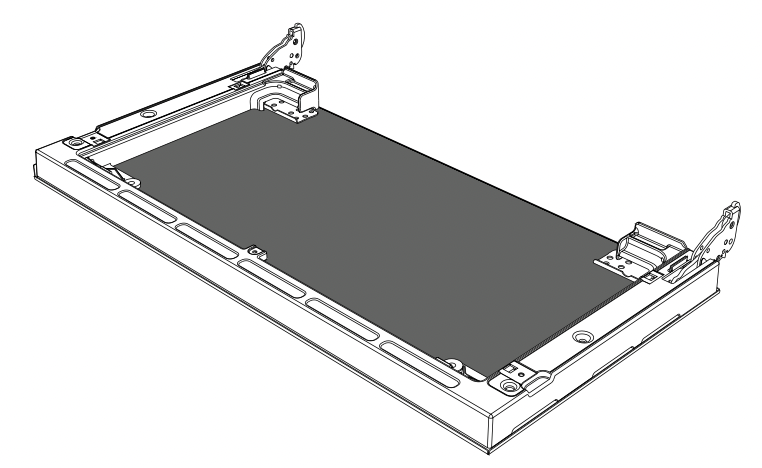
- Refit the panes in the reverse order in which they were removed.
- Reposition the internal glass pane. Take care to centre and insert the 4 pins into their housings in the oven door by applying slight pressure.

Cleaning the inside of the oven
For the best oven upkeep, clean it regularly after having allowed it to cool.
Take out all removable parts.

Clean the oven racks with warm water and non-abrasive detergent. Carefully rinse and dry damp parts.
NOTE: The oven should be operated at the maximum temperature for about 15-20 minutes after the use of specific products, to burn off the residues left inside the oven.
NOTE: For easier cleaning, remove the door.
Removing racks/trays support frames
Removing the guide frames enables the sides to be cleaned more easily. This operation should be performed each time the automatic cleaning cycle is used (on some models only).
To remove the guide frames: Pull the frame towards the inside of the oven to unhook it from its groove A, then slide it out of the seats B at the back.
When cleaning is complete, repeat the above procedures to put the guide frames back in.

Removing the side oven racks/trays support frames
Pull the frame upwards to remove it from its side housings. Replace the frame correctly when you have finished cleaning.

Vapor Clean: assisted oven cleaning
Important: Vapor Clean is an assisted cleaning procedure which facilitates the removal of dirt. Thanks to this process, it is possible to clean the inside of the oven very easily. The dirt residues are softened by the heat and water vapour for easier removal afterwards.
WARNING - Improper use
Risk of damage to surfaces
- Remove any food residues or large spills from previous cooking operations from the inside of the oven.
- Carry out assisted oven cleaning operations only when the oven is cold.
Preliminary operations
Before starting the Vapor Clean cleaning cycle:
- Completely remove all accessories from inside the oven. The upper guard can be left inside the oven.
- Pour approx. 40 cl of water onto the floor of the oven. Make sure it does not overflow out of the cavity.

- Spray a water and washing up liquid solution inside the oven using a spray nozzle. Direct the spray against the side walls, upwards, downwards and towards the deflector.

- Close the door.
NOTE: We recommend spraying approx. 20 times at the most.
Vapor Clean setting
- Turn the function knob to the
 symbol and the temperature knob to the
symbol and the temperature knob to the  symbol.
symbol. - Set a cooking time of 18 minutes using the programmer clock.
- At the end of the cooking time, the timer will switch the oven heating elements off and the buzzer will start to sound.
End of the Vapor Clean cycle
- Open the door and wipe away the less stubborn dirt with a microfibre cloth.
- Use an anti-scratch sponge with brass filaments on tougher encrustations.
- In case of grease residues use specific oven cleaning products.
- Remove the water left inside the oven.
For improved hygiene and to avoid food being affected by any unpleasant odours, we recommend that the oven is dried using a fan assisted function at 160°C for approximately 10 minutes.
NOTE: We recommend wearing rubber gloves for these operations.
NOTE: For easier manual cleaning of the parts difficult to reach, we recommend removing the door.
Extraordinary maintenance
WARNING - Live parts
Danger of electrocution
- Disconnect the oven power supply.
Replacing the internal light bulb
- Completely remove all accessories from inside the oven.
- Remove the racks/trays support frames.
- Remove the bulb cover using a tool (e.g. a screwdriver).

- Slide out and remove the lamp.

NOTE: Do not touch the halogen lamp directly with your fingers, but wrap it in an insulating material. - Replace the lamp with one of the same type (40W).
- Refit the cover correctly, so that the moulded part of the glass is facing the door.
- Press the cover completely down so that it attaches perfectly to the bulb support.
Removing the seal of the auxiliary oven
To permit thorough cleaning of the oven, the door seal can be removed. There are hooks on all four sides to attach it to the edge of the oven. Pull the edges of the seal outwards to detach the hooks.
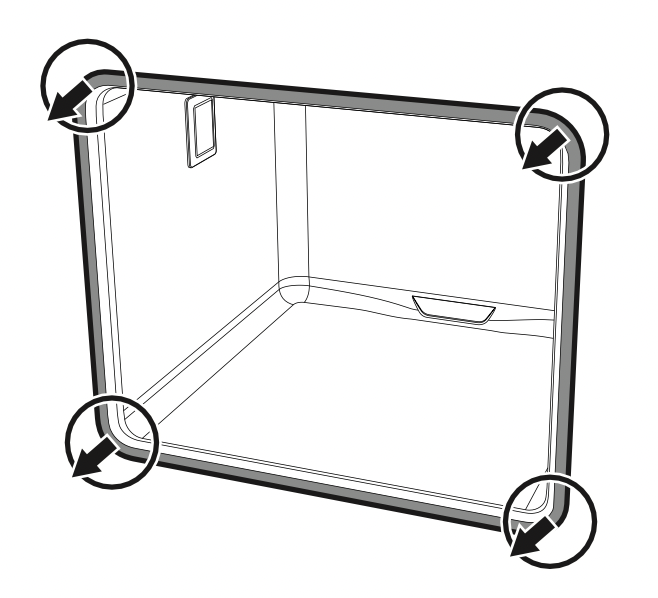
To keep the seals clean, use a non-abrasive sponge and lukewarm water. Seals should be soft and elastic.
See other models: CS95GMNNA KCV60BE2 LP364XS A1PYID-7 KPF9OG
